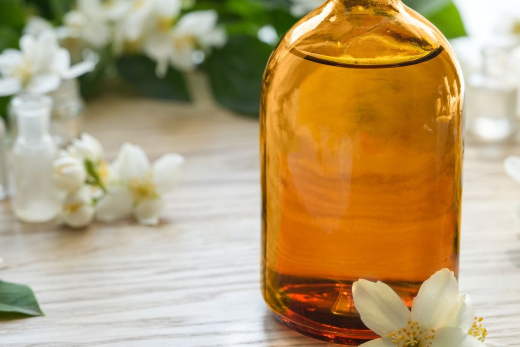Discovering the secrets of fragrance is a fascinating sensory adventure. Our exploration begins with the olfactory pyramid, a complex structure divided into top notes, of heart and base notes. Each note reveals a unique element of the essence, creating a captivating olfactory symphony. Let's plunge together into this sensory journey, where each fragrance tells a unique story, imbued with ingredients carefully selected to awaken our senses and move our souls. Explore our collections of women's fragrances and men to find the fragrance that's right for you.

Understanding the olfactory pyramid of fragrances
The olfactory pyramid is a key structure in perfume creation, divided into three levels : top notes, heart and base notes. Each level reveals a stage in the perfume's evolution on the skin, offering a gradual, harmonious olfactory experience. This model helps perfumers balance scents for a perfect composition. To understand the importance of this structure, it's essential to know what is a perfume and how each component contributes to the overall sensory experience.
Fragrance top notes
Top notes are the first olfactory impressions when a fragrance is sprayed. They are essential for attracting initial attention and include :
- Lightness and freshness : These notes quickly evaporate, leaving room for the heart notes.
- Flavor types : Citrus, fruit and fresh herbs, offering a lively, energizing scent.
- Duration : Generally ephemeral, they last from a few minutes to an hour.
- Role : Grab attention and create an attractive first impression.
- Variety : From sparkling citrus to juicy fruit or aromatic herbs.
The heart notes of a perfume
The heart notes form the main essence of the fragrance, appearing after the top notes and lasting longer:
- Richness and complexity : Richer than the top notes, they add depth to the fragrance.
- Flavor types : Flowers, spices and ripe fruit form the heart of the fragrance.
- Duration : They can last for several hours, leaving a lasting mark on the fragrance's scent.
- Role : Complete the top notes and prepare the transition to the base notes.
- Character :Variety from sweet and romantic to bold and spicy.

Fragrance base notes
Visit base notes are the scents that last the longest, forming the basis of perfume:
- Depth and persistence : Heavier and deeper, they ensure a long-lasting wake.
- Flavor types : Musk, vanilla, sandalwood and amber bring stability and richness.
- Duration : Persistent, they can remain on the skin for hours after application.
- Role : Form the foundation of the fragrance on which the other notes develop.
- Impact : Influence the perception of lighter notes, adding complexity to the fragrance.
The different types of ingredients in perfumery
In perfumery, a variety of ingredients are used to create unique aromas. These components fall into three main categories: top notes, which are quickly perceptible after application; middle notes, which form the essence of the fragrance; and base notes, which are the most persistent. Perfumers integrate a variety of elements, such as florals for a range of scents, fruits for a touch of sweetness, spices that add warmth and intensity, woods for their depth, resins for a balsamic scent, and musks, which lend a velvety sensuality to the fragrance. By understanding these categories, we can better apprehend the different types of fragrance. fragrance types types de parfums and choose the right one for each occasion.

The Flowers
Floral essences play a central role in perfume composition, offering a diversity of olfactory notes that captivate and enchant. Here's a closer look at some of the emblematic flowers used in perfumery:
- Rose : A symbol of romance and luxury, rose extract is obtained mainly from the petals. These contain a multitude of volatile components that contribute to its rich, nuanced fragrance. Rose essential oils are highly prized for their deep, persistent fragrance, capable of giving body to a scent and making it instantly recognizable.
- Orchid : Known for its sophistication, the orchid offers a spectrum of scents that varies enormously according to species. Orchid extracts add an exotic touch to fragrances, making them complex and multilayered. In perfumery, orchids are often used for high-end creations because of their unique, hard-to-imitate aroma.
- Jasmine : Another pillar of floral perfumery, jasmine is famous for its powerful, sensually bewitching scent. The extraction of its essential oils is delicate and costly, but the result is a component that can radically transform the depth and appeal of a perfume.
These floral essences are carefully selected and combined by perfumers to create fragrances that are not only pleasant to smell, but also evoke emotions and memories, making each scent an olfactory work of art.
Fruit
- Fruity essences captivate with their freshness and vitality, playing a crucial role in the creation of dynamic, appealing fragrances:
- Apple: Known for its fresh, sparkling fragrance, apple extract adds a note of lightness and liveliness to compositions.
- Banane : Avec son arôme doux et tropical, la banane offre une touche exotique, apportant une dimension gourmande unique.
- Lemon: The acidity and freshness of lemon are ideal for energizing top notes, giving an immediate, recognizable radiance.
- Strawberry: Sweet and juicy, strawberries add a touch of sweetness and slightly acidity, much appreciated in young, playful fragrances.
- Peach: Peach offers a velvety, fruity richness, contributing to warm, enveloping fragrances.
- Cherry: Cherry enriches fragrances with its sweet, slightly tart profile, adding fleshy depth and a glowing nuance to compositions.
These diverse fruits each bring their own unique character to fragrances, allowing perfumers to play with a wide range of fruity notes to create scents that are complex, memorable and invigorating.
Discover our “Varens Sweet” collection, a symphony of fragrances where each fruity note invites you to savor the sweetness of deliciously scented moments.

Woods
Woody essences bring enveloping warmth and sophisticated depth to many fragrances, especially for men, but also for women, for their timeless, universal character:
- Cedar: Renowned for its warm, woody scent, cedar is often used for its robustness and ability to anchor fragrances with a resinous note.
- Sandalwood: Prized for its rich, creamy aroma, sandalwood adds a smooth, lingering complexity much sought-after in high-end fragrances.
- Vetiver: With its earthy, slightly smoky notes, vetiver is prized for its refined olfactory profile, which adds a discreet elegance.
- Pine: Offering a resinous freshness, pine is used for its invigorating impact and clarity, bringing an airy dimension to fragrances.
- Patchouli: Patchouli's deep, slightly sweet notes make it a favorite for adding a mysterious, sensual base to compositions.
These diverse woods offer a palette of nuances that enrich fragrances, giving them body and character.
Spices
Used for centuries, spices enrich fragrances with their warm, deep aromas:
- Varieties: Pepper, cinnamon, cloves, ginger, cardamom and nutmeg.
- Effects: Bring warmth and exoticism, ideal for autumn and winter fragrances and appreciated in unisex compositions.
- Use: Spices can enhance a fragrance, adding spicy or sweet nuances depending on the spice chosen.
Balms and resins
Balms and resins are precious ingredients in perfumery. They are often used as base notes, bringing depth and longevity to a fragrance. The balsams and resins most commonly used in perfumery are benzoin, myrrh, frankincense, labdanum and opoponax. These ingredients have a richness and complexity that add a luxurious dimension to a fragrance. Benzoin, for example, has a sweet, vanilla-like scent, while myrrh has a more earthy, woody odor. Frankincense, meanwhile, has a resinous, slightly lemony scent, while labdanum has a sweet, musky odor.
Olfactory families in perfumery
Perfumery, an art rich in essences, is structured around olfactory families classified according to their dominant notes. Each fragrance is defined by its main aroma, although its components may cross several families. Olfactory families, such as floral or woody, can be subdivided into sub-families (fruity floral, spicy woody, etc.) to refine their description. These classifications help you choose a fragrance to suit your preferences, whether they are for mild or more robust scents. The concentration of essential oils in the fragrance also influences the final choice.
Floral olfactory family
The floral olfactory family is one of the oldest and most popular in perfumery. It is characterized by floral notes, which can be soft and delicate or strong and penetrating. Floral essences can be unisex, but are generally associated with feminine fragrances. Floral fragrances can be made from a variety of flowers, such as rose, jasmine, ylang-ylang, violet and so on. They can also be combined with other notes, such as fruits, spices or woods, to create more complex fragrances. Floral fragrance molecules are generally associated with femininity, softness and romance.
Floral fragrances have a long history in perfumery. They were first used in ancient Egypt and have continued to be popular throughout history. The concentration of essential oils in a bottle of floral perfume can vary, which can influence the intensity of the aroma.
Practical tip: Floral fragrances are particularly well suited to formal appointments and events where a subtle yet captivating scent is called for.
Woody olfactory family
Woody essences are at the heart of fragrances that express stability and strength. Woods like cedar bring an earthy, robust note, while sandalwood offers a creamy sweetness, making these fragrances ideal for those seeking to project an image of confidence and resilience. Woody fragrances can be complemented with spicy touches for a sensation of warmth, or with marine notes for unexpected freshness.
Woody fragrances have an ancient history in the world of perfumery, dating back to Antiquity, and they have maintained their popularity through the ages.
Practical tip: Opt for a woody fragrance for professional occasions or outdoor events where a strong, earthy scent is appreciated.
Amber (oriental) olfactory family
The amber olfactory family, also known as oriental, is renowned for the richness and sensuality of its essences. Here are the key points that characterize this family:
- Characteristics: Amber fragrances are warm and sensual, evoking the luxurious exoticism of the Orient.
- Main components:
- Amber: A fossil resin with a soft, warm fragrance, fundamental for its depth and longevity.
- Resins and spices: Contribute to the complexity and richness of fragrances.
- Tobacco and exotic woods: Add a touch of mystery and opulence.
- Associated notes: Vanilla, benzoin and labdanum, which together create a warm, enveloping ambience.
- Use: Ideal for evenings out or special occasions, these fragrances underline a bold, luxurious character.
- Longevity: The high concentration of these fragrances guarantees exceptional longevity on the skin.
Fragrances from the amber family are perfect for those seeking striking, luxurious fragrances, adding a dimension of sophistication and exclusivity to any fragrance collection. These essences are designed to leave a lasting impression, making this family an essential pillar of perfumery.




